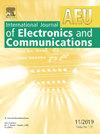A filtering power divider with high selectivity based on surface acoustic wave resonator
IF 3.2
3区 计算机科学
Q2 ENGINEERING, ELECTRICAL & ELECTRONIC
Aeu-International Journal of Electronics and Communications
Pub Date : 2025-09-04
DOI:10.1016/j.aeue.2025.156025
引用次数: 0
Abstract
In this paper, a novel filtering power divider (FPD) based on surface acoustic wave (SAW) resonators is proposed. The proposed FPD integrates the functions of a SAW resonator filtering structure and a power divider, providing highly selective filtering response at two output ports. Microstrip transmission lines, inductors, and SAW resonators are integrated to form the filtering structure that functionally substitutes the quarter-wavelength microstrip line in the traditional Wilkinson power divider. Owing to the symmetry of the circuit topology structure, odd- and even-mode methods are used for analysis. To validate the proposed technique, a high-selectivity FPD based on SAW resonators is designed and fabricated. Measurement results demonstrate an operating bandwidth (return loss > 15 dB) of 989.6–1006.5 MHz with a minimal insertion loss of 1.4 dB. Across the entire passband, the output port isolation exceeds 21 dB, and the shape factor (BW3dB/BW10dB) is 0.81. The FPD owns advantages of high frequency selectivity and good isolation.
一种基于表面声波谐振器的高选择性滤波功率分配器
提出了一种基于表面声波(SAW)谐振腔的滤波功率分配器。所提出的FPD集成了SAW谐振器滤波结构和功率分配器的功能,在两个输出端口提供高选择性滤波响应。将微带传输线、电感器和声表面波谐振器集成在一起,形成滤波结构,在功能上替代传统威尔金森功率分压器中的四分之一波长微带线。由于电路拓扑结构的对称性,采用奇模和偶模方法进行分析。为了验证所提出的技术,设计并制作了一个基于SAW谐振器的高选择性FPD。测量结果表明,工作带宽(回波损耗>; 15 dB)为989.6-1006.5 MHz,最小插入损耗为1.4 dB。在整个通带中,输出端口隔离超过21 dB,形状因子(BW3dB/BW10dB)为0.81。FPD具有频率选择性高、隔离性好等优点。
本文章由计算机程序翻译,如有差异,请以英文原文为准。
求助全文
约1分钟内获得全文
求助全文
来源期刊
CiteScore
6.90
自引率
18.80%
发文量
292
审稿时长
4.9 months
期刊介绍:
AEÜ is an international scientific journal which publishes both original works and invited tutorials. The journal''s scope covers all aspects of theory and design of circuits, systems and devices for electronics, signal processing, and communication, including:
signal and system theory, digital signal processing
network theory and circuit design
information theory, communication theory and techniques, modulation, source and channel coding
switching theory and techniques, communication protocols
optical communications
microwave theory and techniques, radar, sonar
antennas, wave propagation
AEÜ publishes full papers and letters with very short turn around time but a high standard review process. Review cycles are typically finished within twelve weeks by application of modern electronic communication facilities.

 求助内容:
求助内容: 应助结果提醒方式:
应助结果提醒方式:


